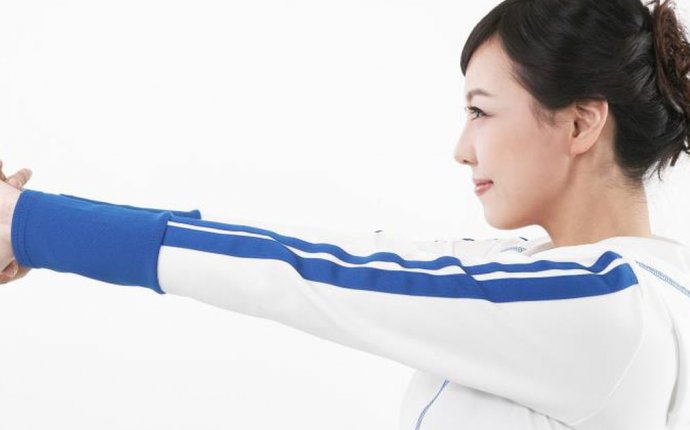
Back Strain Stretch
1. Neck and chest stretch
Even before the prevalence of screens in our lives, humans still jutted their chins forward or down on a regular basis, to read, to eat (when we look at our plates), to drive, and so on. This causes neck pain and can contribute to pain in other parts of our spine and back, typically the upper and midspine. The movement below helps ease this pain and also stretches out the chest, which can feel tight from bad posture and needs to be opened back up.
Muscles worked: This stretches your scapulae and trapezius muscles in your neck as well as your pectorals and erector spinae, and gently works your obliques.
- Begin seated, feet flat on the floor, sitting up straight. Bring your hands to rest at the base of your skull, fingers intertwined, thumbs running by your ears and down your neck. (This is the classic “relaxed, laid back” pose, with your head resting in your hands.)
- Ease your head back into your hands, turning your face toward the ceiling.
- Inhale deeply. As you exhale, ease your left elbow so it’s pointing more toward the ground, your right elbow toward the ceiling. This will stretch your neck in a supported way. Note: This should be an easy movement, so if it’s a slight movement and your elbows only move an inch or 2, that’s fine. It should feel like a good stretch, not painful.
- Take 2 deep breaths and ease yourself back to neutral, spine upright.
- Repeat on other side, right elbow toward the ground, left elbow toward the ceiling. Do this 3 times on each side, alternating sides as you go.
Gentle backbend
2. Seated gentle backbend
Our upper and midback (the thoracic and cervical spine) begin to curve forward even more as we age, thanks to our chins jutting out or down, as mentioned above, and also because of how often we perform this motion throughout our lives. It can become our regular posture, as opposed to our “lazy” posture. This contributes to the hunch that we often associate with getting older, and it can cause tension in our back muscles. That tension can be counteracted by this gentle backbend.
Muscles worked: This stretch uses your spinal extensors, anterior neck muscles, and pectorals.
- Starting seated, feet flat on the floor, bring your hands to your lower back, with your fingers facing down and thumbs wrapped around your hips toward your front body.
- Press your hands firmly into your hips/lower back and inhale.
- As you exhale, gently arch your spine, leading with your head. Note: You don’t want your head to drop back too much. You do, however, want to lead with your cervical spine, so tilting your chin up, face to the ceiling, is a good, gentle start. The backbend should happen throughout the upper and midspine.
- Hold for 5 full, deep breaths.
- Gently and slowly come back to the neutral starting position, and repeat 3 to 5 times.
Reach back
3. Reach back
This stretch helps with range of motion in your shoulders as well as stretching your shoulders and chest. When we sit hunched forward or stand leaned over, it can feel good, as though we’re resting into a slouch. However, this creates tension in our chests from pulling those muscles in. And it can cause pain in our upper and midbacks, by avoiding working those muscles. The movement below opens the chest up, works the postural muscles, and improves shoulder extension.
Muscles worked: This stretch gives your anterior deltoids a lovely stretch as well as your pectorals.
- Sit with spine straight, feet planted firmly on the ground. Inhale deeply, and as you exhale, reach behind you and interlace your hands. Note: If you cannot interlace your hands, grab opposite wrists or elbows.
- Inhale deeply again, and feel your spine growing longer as you sit up taller. Roll your shoulders up and back, moving your shoulder blades down your back.
- As you exhale, gently straighten your arms, if your hands are clasped. (If your hands are not clasped, gently pull in opposite directions.) This will open up your upper back.
- After 3 deep breaths, release your clasp and return to neutral.
- Repeat this 3 times.
Take it to the next level
If the above feels good and not like anything is being strained, you can increase the stretch and get the entire spine involved. It can help relieve pain in other parts of your back as well as increase spinal mobility.
- Start with the above stretch, getting into position with your hands clasped behind your back or grasping opposite wrists or elbows.
- Inhale and feel your ribs lift and your spine grow longer. Keeping that feeling in your spine, gently lean forward at the waist, as though bringing your ribs to your thighs.
- Only go as far as feels good. If you can go all the way down to your thighs, that’s fine, but do not collapse onto your legs. You still want to be using your postural muscles to hold you here and stretch your chest, shoulders, and back.
Seated Cat-Cow
4. Seated Cat-Cow
The lower back is where a lot of people feel pain. As we age, spinal degeneration and osteoarthritis become much more common. It is also common for some of us to stand with a “flat pelvis” when we have poor posture, which can cause quite a bit of lower back pain. Doing Cat-Cow helps stretch the lower back muscles as well as working some of the core muscles and keeping the spine healthy.
Muscles worked: This works and stretches (since it is a combination of 2 poses) your erector spinae, serratus anterior, iliac rib muscle, and abdominal external oblique and rectus abdomius.









